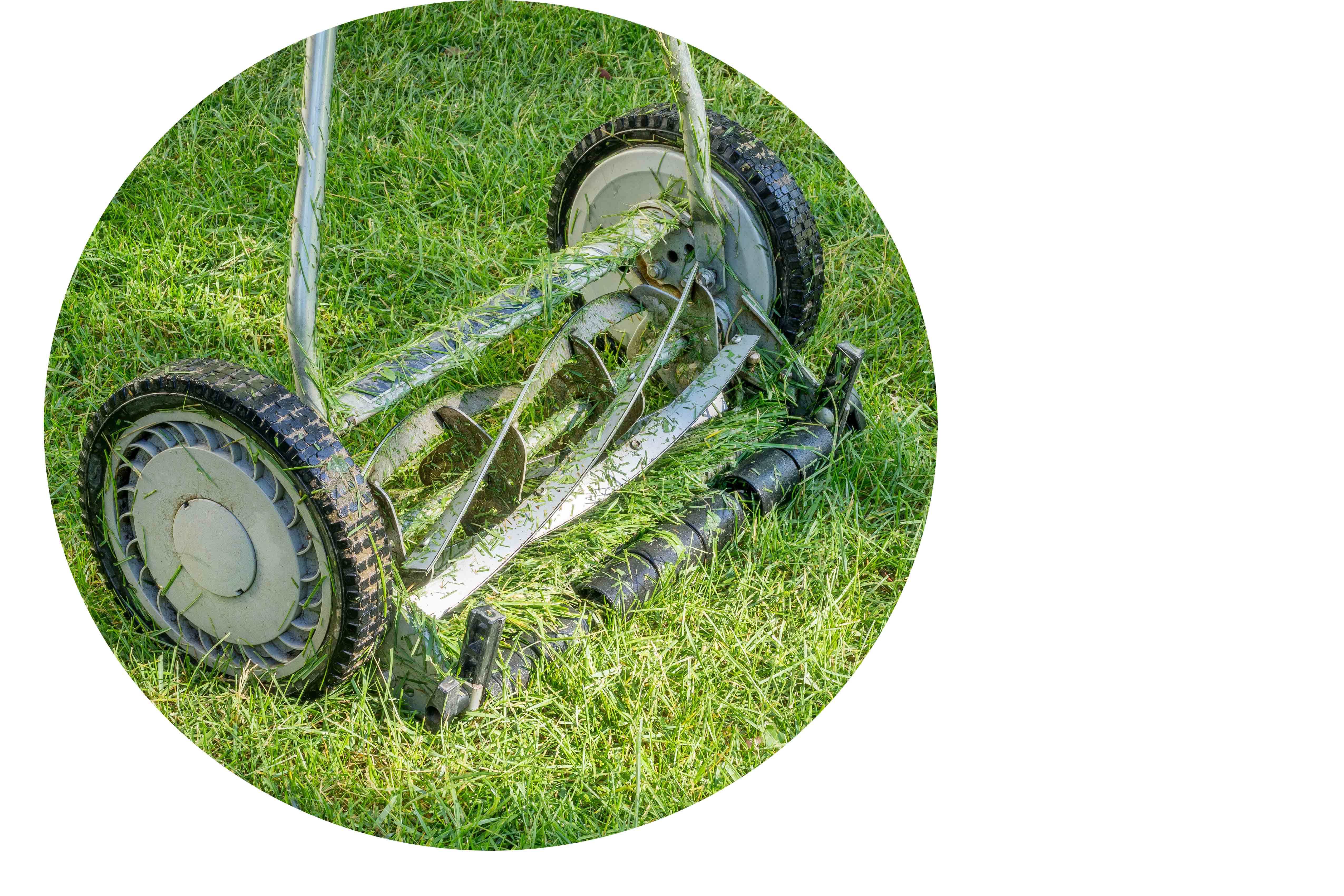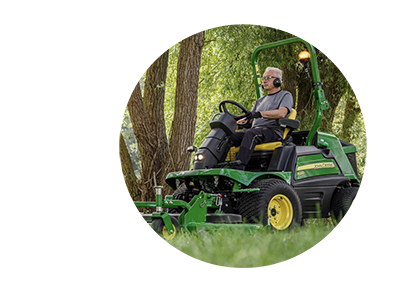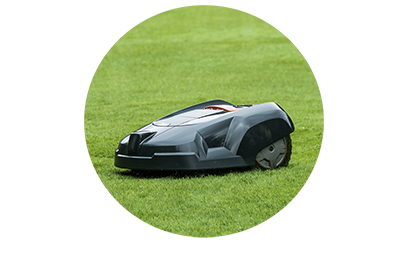When choosing a lawnmower, you need to consider a number of factors. The right choice of lawnmower for you depends on the size of your lawn, but also on the power source you want to use. We offer a comprehensive part range for all types of lawnmowers, from manual push lawnmowers, corded electric lawnmowers (for small gardens or tight spaces), robotic lawnmowers and petrol-powered lawnmowers to ride-on mowers for larger areas. Read everything you need to know about each type of lawnmower in this article
Push cylinder lawnmower
Of simple design, this lawnmower has two wheels that drive a sharp blade cylinder to cut the grass. This type of mower is easy to use and eco- friendly. However, regular sharpening or replacement of the blades is necessary to keep the lawnmower in good working condition.
Features
- Cutting height: 13 to 42mm
- Cutting width: 30 to 40cm
- 4 or 5 spinning blades
- Optional: grass assembly
- Adjustable and/or foldable guide rail
 Handmower
HandmowerInstructions for use
Push lawnmowers are most effective when used on lawns with short grass. If the grass becomes too tall, operating a push lawnmower is highly labour-intensive and the results will be uneven. In the growing season, you should probably mow your lawn at least every week to maintain an even result. Later in the season, every two weeks as a minimum is advisable. Depending on how often you use the lawnmower, and the presence of stones, sand and molehills in your garden, the cutting blade should be replaced regularly. Prepare for mowing season and order your replacement blades from Kramp now.
Click here for spare parts for your push mower >>
Corded or battery-powered electric lawnmower
Electric lawnmowers are especially suitable for urban gardens, as they tend to be compact and quiet. The power of corded models (230 volts) or the voltage of battery-powered models varies depending on the cutting width. The higher the power, the more powerful the lawnmower. The battery capacity (in Ah) of a cordless lawnmower determines its runtime (in hours and minutes). The higher the capacity, the longer the runtime. The batteries usually consist of fast-charging lithium-ion cells.
We recommend choosing the right electric lawnmower for you based on the size of your green space or the desired cutting width:
- 1000 to 1300W for gardens ≤ 300m²
- 1400 to 1800W for gardens ≤ 700m²
- 18V and 2Ah for green spaces ≤ 300m²
- 36V or higher and 3Ah or higher for lawns ≤ 500m²
Features
- Cutting height: 15 to 75mm
- Cutting width: 30 to 53cm
- Power: 700 to 1800W
- Voltage of cordless lawnmowers: 18 to 80V
- Power of cordless lawnmower: 2 to 10Ah
- Lithium-ion battery: 2 to 10Ah
- Optional: mulching function
- Optional: wheel drive
 Lawnmower
LawnmowerInstructions for use
As an electric lawnmower is plugged in, it is important to observe the safety instructions when operating it. To avoid an electric shock, be careful not to accidentally cut the cord while mowing. When using a cordless lawnmower, you might want to have access to a second, charged battery.
Petrol-powered lawnmower
Petrol-powered lawnmowers are robust and used mainly in rural areas or large gardens. This type of lawnmower is recommended for areas of 700 m² or more. The engine requires regular maintenance, including oil changes and refuelling with petrol and an additive (for two-stroke engines), spark plug maintenance and air filter cleaning. The engine also has to be prepared for winter storage (comprehensive wear-and-tear inspection of its parts as well as an oil change). The previously common models with two-stroke engines (petrol-oil mixture as lubricant) are now being replaced by four-stroke engine models (petrol and oil as separate lubricants). The power of these models is expressed in horsepower (hp) or kilowatts (kW). The following equation applies: 1 hp = 0.74 kW. Cylinder capacity is measured in cubic centimetres (cm³). We recommend choosing the right petrol-powered lawnmower for you based on the size of your green space, which in turn affects the cutting width:
- 2.6kW or 3.5hp, 160cm³ for 2,000m²
- 2.2kW or 3hp, 150cm³ for 1,500m²
- 1.8kW or 2.4hp, 100cm³ for 900m²
Features
- Cutting height: 15 to 90mm
- Cutting width: 40 to 84cm
- Power: 1.6kW or 2.1hp to 3.6kW or 5hp
- Engine capacity: 100 to 200cm³
- Optional: mulching function
- Optional: wheel drive
- Manual start (pull cord) or electric start
Instructions for use
The engine should be serviced regularly (oil, air filter, spark plugs, petrol) and regular lubrication of cables and cable guides is required. Lawnmowers with electric start also have a battery that needs to be disconnected in winter and charged with a trickle charger to keep it in working condition.
Recommended accessories and spare parts:
Garden tractor or ride-on mower
A garden tractor, also known as a lawn tractor or a ride-on mower, is specially designed for maintaining large lawns of more than 3,000 m². They offer a large cutting width and are easy and comfortable to operate. A ride-on mower is a heavy, powerful and robust machine. It has a gearbox with a number of forward and reverse gears. Most ride-on mowers are now equipped with a hydrostatic drive, which provides for a smooth and infinitely variable speed control.
The cutting deck of a ride-on mower is usually centrally located under the tractor. On front mowers, it is mounted on the front of the machine. Again, we recommend choosing the right ride-on mower for you based on your desired cutting width:
- 66 to 80cm cutting width, 8.2kW or 11hp, 190cm³ for 2,000m²
- 85 to 107cm cutting width, 9.7kW or 12.8hp, 500cm³ for 5,000m²
- 107 to 125cm cutting width 11.5kW or 15.5hp or more
Features
- Cutting height: 30 to 90mm
- Cutting width of ride-on mowers: 66 to 125cm
- Power: 8.2kW or 11hp to 17kW or 23hp
- Engine capacity: 190 to 600cm³
- Optional: mulching function
- Optional: assembly bag
- 3 to 6 forward gears, 1 reverse gear or hydrostatic drive
- Electric start (on battery)
- Classic gearbox with mechanical shifting
- Hydrostatic transmission with stepless gearshift
- Rear discharge with or without catch tray
- Side discharge with mulching function
- Optional: headlights
 Lawntractor
LawntractorInstructions for use
A ride-on lawnmower requires regular engine maintenance. The blades need to be cleaned with a cleaning aid. We recommend engaging a professional for maintenance and technical troubleshooting. If you want to use your ride-on mower on uneven terrain, you should opt for a small turning circle and a high cutting height to achieve the best results.
Click here for lawnmower maintenance products >>
Robotic mower
Robotic mowers are the latest development in the garden and park industry. They operate autonomously without the need for human intervention. A robotic mower returns to the charging station by itself when the battery charge level falls below a certain threshold. Robotic mowers are not suitable for use on slopes (+35%). They are available with or without boundary wire. The performance of a robotic mower is highly advanced, as it can cut up to 500m² of grass in just 60 minutes. That said, a robotic mower can only cut low grass heights, which means that frequent mowing sessions are required. A robotic mower is able to detect obstacles and high-tech models come with solar panels. The maximum area coverage of the most powerful models is around 75,000m².
Features
- Waterproof
- With lift and tilt sensor (blades are blocked when the robot is tilted)
- Anti-theft protection (lock code)
- Collision sensor
- Maximum slope of 35%, depending on model
- Estimated area capacity of about 1,000 to 75,000m²
 Robotmower
RobotmowerRobotic mower with boundary wire
Boundary wire is used to define the boundaries of the mowing area, for example to avoid flower beds or stony areas. The boundary wire (approx. 150m), hooks, wire connectors and connection clamps are included with the mower.
We have listed the advantages of professional installation of the boundary wire for you below.
Properly installed boundary wire: the boundary wire is typically installed by burying it, reducing the risk of damage or breakage. This acts as an invisible fence, ensuring that the robotic mower stays within the perimeter of the designated area.
Optimal coverage: the boundary wire is placed around the perimeter of the area you want the robotic mower to cover. This ensures that the robotic mower works efficiently and effectively, providing even and consistent mowing results.
Time-saving: having boundary wire installed will save you a lot of time and effort, especially if you have a large lawn. Installing the wire correctly is a time-consuming, but essential, activity. If the wire has been installed properly, the robot will operate effortlessly within the designated mowing area only.
Safety: professional installation of the boundary wire ensures that the wire is safely buried and protected from damage. This reduces the risk of accidents or damage to the robotic mower or other equipment, which can be expensive to repair or replace.
Sustainable results: if the wire is properly installed, the robotic lawnmower will have a longer life. It will reduce the risk of repairs or replacements, resulting in financial benefits.
Robotic mower without boundary wire
A robotic mower will detect obstacles and avoid them automatically. The boundaries can be set on an electronic map or the mower has features such as drop sensors to detect the edge of the lawn. Some robotic mowers are now also equipped with GPS.
Click here for robotic mower parts and accessories >>
Maintenance is essential for all lawnmower types
Lawnmowers require regular maintenance for the best operating comfort and a perfect cutting result. The blades of a mower should be replaced frequently. The basic rule is as follows: if the cut grass blades are cracked, browned or withered, the blade is too blunt. Heavy vibrations during mowing are another sure sign of the need for maintenance. Regular maintenance is a prerequisite for an efficient and comfortable mowing job and optimum mowing results.
Click here for our range of lawnmower blades >>
Petrol-powered lawnmowers have four-stroke engines. These need regular oil changes or spark plug maintenance. Ride-on mowers require regular hydraulic oil and V-belt changes, as well as tyre pressure checks, preferably by a specialist. We have listed our recommended products below.
Motor oil favourites:
Click here for our recommended V-belts >>
Important note: four-stroke engines usually require unleaded fuel, including E10 depending on the manufacturer. Two-stroke engines require a mixture of petrol and oil. Please follow the manufacturer’s instructions to avoid damaging your lawnmower.
Share this article with your customers
Feel free to share this article with your customers so that they can prepare for mowing season. Please do not hesitate to contact our product specialist, find a Kramp dealer near you or contact us at knowledgecenter@kramp.com if you have any questions or require more information

